
Rail transport in New Zealand is an integral part of New Zealand's transport network, with a nationwide network of 4,375.5 km (2,718.8 mi) of track linking most major cities in the North and South Islands, connected by inter-island rail and road ferries. Rail transport in New Zealand has a particular focus on bulk freight exports and imports, with 19 million net tonnes moved by rail annually, and 99.5% of New Zealand's exports and imports being transported through the country's seaports.
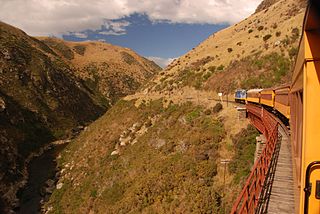
Dunedin Railways is the trading name of Dunedin Railways Limited, an operator of a railway line and tourist trains based at Dunedin Railway Station in the South Island of New Zealand. The company is a council-controlled trading organisation wholly owned by Dunedin City Council through its holding company Dunedin City Holdings Limited.
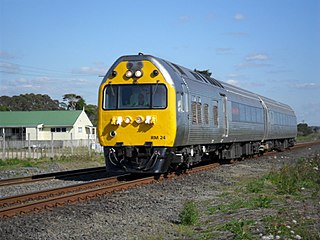
The NZR RM class Silver Fern was a class of rail motor in New Zealand. The three air-conditioned and sound-proofed 723-kW 96-seater diesel-electric twin-set railcars were built by Kawasaki under contract with Nissho Iwai of Japan. New Zealand Railways (NZR) classified the railcars as RM (Rail Motor), the same as other railcars, using the Silver Ferns (a national symbol of New Zealand) because of their exterior was made of corrugated stainless steel, like the premier night sleeper train that also ran on the Wellington-Auckland (North Island Main Trunk) route, the Silver Star. The Silver Ferns replaced the three successful Blue Streak railcars on the service.
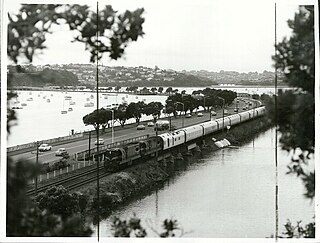
The Silver Star was a luxury passenger train that ran overnight between Auckland and Wellington on the North Island Main Trunk (NIMT) railway of New Zealand, operated by New Zealand Railways (NZR). The train ran from Monday 6 September 1971 until Sunday 8 June 1979. It replaced the Night Limited express passenger trains which provided a faster service than the ordinary express trains, by stopping at only six intermediate stations en route and not hauling a postal (sorting) van as on previous trains.
The Southerner was a passenger express train in New Zealand's South Island between Christchurch and Invercargill along the South Island Main Trunk, that ran from 1970 to 2002. It was one of the premier passenger trains in New Zealand and its existence made Invercargill the southernmost passenger station in the world.

Hillside Engineering Group is a trading division of the rail operator KiwiRail in Dunedin, New Zealand. Most of its work is related to KiwiRail, but it also does work for the marine industry in Dunedin. On 19 April 2012 KiwiRail announced it was putting Hillside on the market for sale. In November 2012 KiwiRail announced it had sold part of the business to Australian firm Bradken, and the rest would be closed. The workshops continued to be used for some maintenance work by Kiwirail with a skeleton staff. In October 2019, the New Zealand Government announced that it would be investing NZ$20 million into revitalising Hillside Engineering as a major mechanical hub and engineering facility to service Kiwi Rail's locomotives and rollingstock.
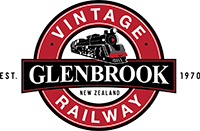
The Glenbrook Vintage Railway (GVR) is a heritage steam railway in Glenbrook, New Zealand.
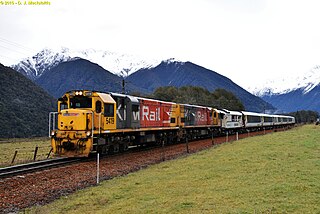
The TranzAlpine is a passenger train operated by the Great Journeys New Zealand division of KiwiRail in the South Island of New Zealand over the Midland Line; often regarded to be one of the world's great train journeys for the scenery through which it passes. The journey is 223 kilometres (139 mi) one-way, taking almost five hours. There are 16 tunnels and four viaducts, with the Staircase Viaduct elevated as much as 75 metres (246 ft).
This is a list of jargon commonly used by railfans and railway employees in New Zealand.
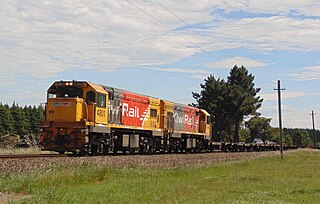
The New Zealand DC class locomotive is a type of diesel-electric mainline locomotive on the New Zealand rail network, operated by KiwiRail on freight trains, and formerly on long-distance passenger trains. The class was rebuilt from the DA class in the late 1970s and early 1980s, mainly in Australia. After the DA class, they were the most numerous class of diesel locomotive on New Zealand's railway network and remained numerically dominant until the mid-2010s when withdrawals began.
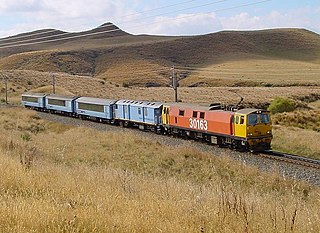
The Overlander was a long-distance rail passenger train between Auckland and Wellington in the North Island of New Zealand, along the North Island Main Trunk (NIMT). It was operated by Tranz Scenic. The service was replaced from 25 June 2012, by the Northern Explorer.
The Northerner was an overnight passenger train between Wellington and Auckland in New Zealand. The train replaced the unnamed and ordinary express trains supplementing the luxury Silver Star, which had replaced the Night Limited in 1971. The Northerner operated from 1975 to 2004.
The Bay Express was a passenger train between Wellington and Napier in New Zealand's North Island, operating from Monday, 11 December 1989 until Sunday, 7 October 2001. It was operated by New Zealand Railways Corporation's InterCity Rail division, later known as Tranz Scenic.

The Coastal Pacific is a long-distance passenger train that runs between Picton and Christchurch in the South Island of New Zealand. It is operated by the Great Journeys New Zealand division of KiwiRail. It was called the TranzCoastal from May 2000 until temporarily withdrawn in February 2011. It was the first train to use the new AK class carriages.

The Wairarapa Connection is a New Zealand interurban commuter rail service along the Wairarapa Line between Masterton, the largest town in the Wairarapa, and Wellington. It is operated by Wellington suburban operator Transdev under contract from the Greater Wellington Regional Council. It is a diesel-hauled carriage service, introduced by the New Zealand Railways Department in 1964 after passenger demand between Masterton to Wellington exceeded the capacity of the diesel railcars then used.
The Picton Express was a passenger express train operated by the New Zealand Railways Department (NZR) between Christchurch and Picton. It ran from December 1945 until February 1956, and was thus the shortest-lived provincial express in New Zealand. Following the end of railcar services in 1976, a new carriage train between Christchurch and Picton began, under the same name as the earlier service, until it was replaced in 1988 by the Coastal Pacific Express.

The NZR 56-foot carriage is a class of 56 ft (17 m) long railway passenger carriage formerly used on almost all long-distance passenger rail transport in New Zealand. 88 carriages have been preserved.

The New Zealand British Rail Mark 2 carriages were built by British Rail Engineering Limited for British Rail in the early 1970s. From the mid-1990s, 150 were exported to New Zealand. After being rebuilt, refurbished and re-gauged, they entered service with a variety of operators on New Zealand's railway network. The carriages generally replaced older NZR 56-foot carriages, some of which had been in use for almost 70 years.

The New Zealand AK class carriage is a class of 17 cars built by Dunedin's Hillside Workshops for KiwiRail's long-distance passenger operation The Great Journeys of New Zealand. Consisting of 11 AK saloon carriages and four AKC café carriages, supplemented by three AKL luggage vans and four AKV open-air viewing/generator vans converted from AG vans, similar to those previously used on the Coastal Pacific and the TranzAlpine. The AK class are the first new carriages to be built in New Zealand since 1943.

The Northern Explorer is a long-distance passenger train operated by the Great Journeys New Zealand division of KiwiRail between Auckland and Wellington in the North Island of New Zealand, along the North Island Main Trunk (NIMT). Three services operate per week in each direction between Auckland's The Strand Station and Wellington railway station. The Northern Explorer replaced the Overlander from 25 June 2012.
















